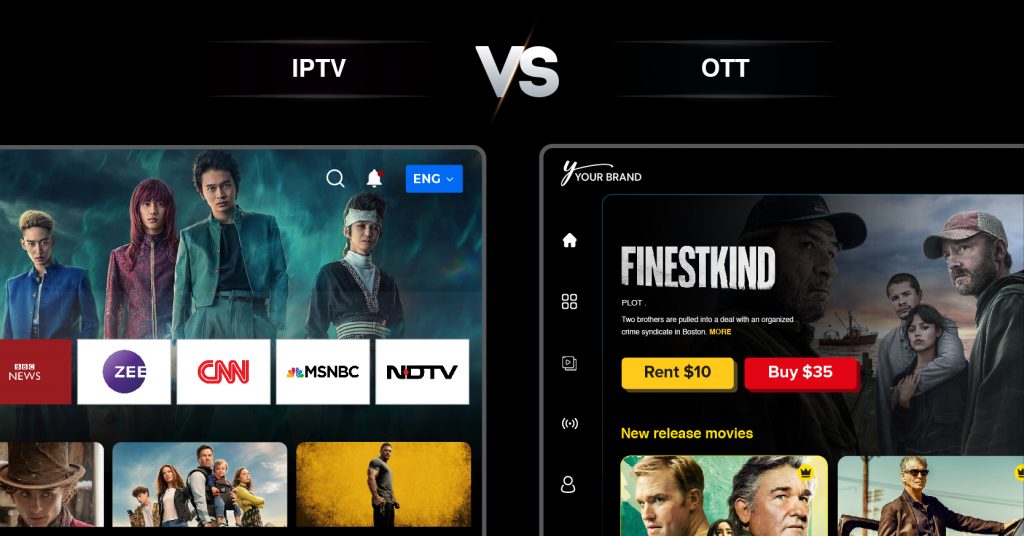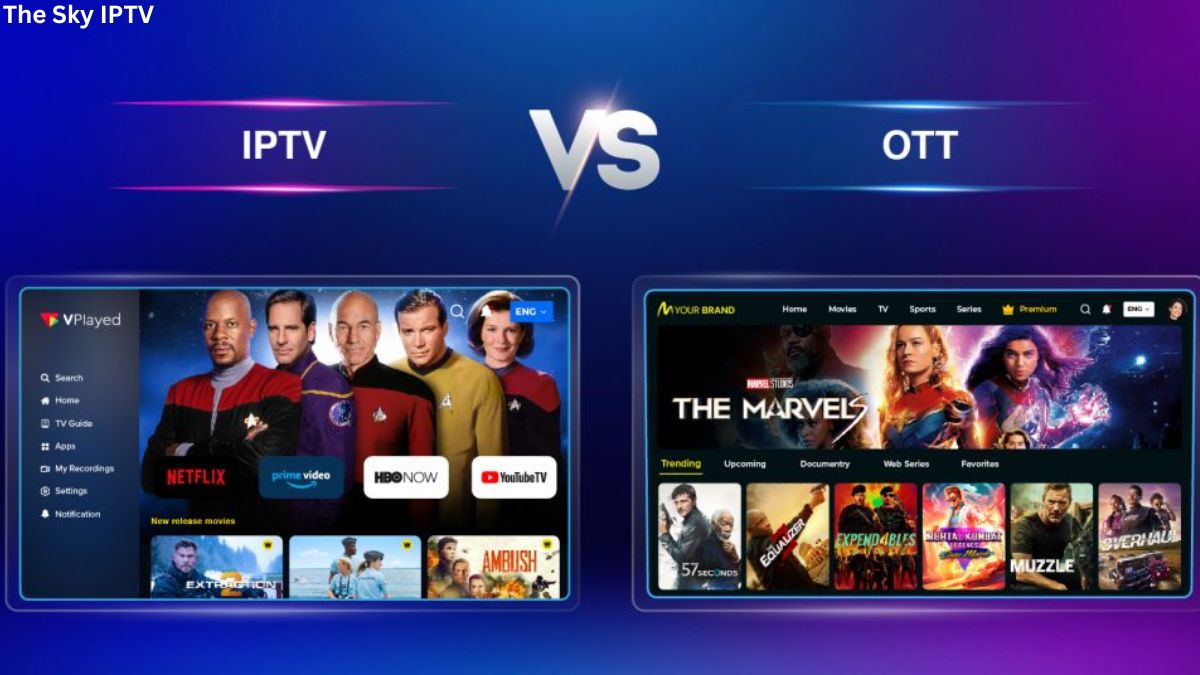Regarding internet streaming, the phrases OTT vs IPTV are often used, presenting a problem for organizations looking for the best streaming option. While both play important roles in the shift from conventional broadcasting to Internet-based streaming, they are unique entities, each with its features.
Consumers are embracing the freedom of on-demand programming as set TV schedules become obsolete. According to Techjury, the transition away from cable and satellite TV is expected to be dramatic, with a 26% decrease in penetration by 2030.
Understanding the distinctions between OTT vs IPTV UK becomes more crucial during this transitional period. The worldwide OTT Video market is expected to reach US$295.40 billion by the end of 2024, with a 7.30% annual growth rate resulting in a market volume of US$420.10 billion by 2028 (Statista).
So, what distinguishes OTT vs IPTV, and how can companies pick the one that best meets their needs? Join us on this blog to learn the differences between IPTV and OTT and make an educated choice about your future streaming choices. Let’s get started.
What is IPTV (internet protocol television)?
IPTV, or Internet Protocol Television, has evolved as a game-changing idea in the current entertainment industry, revolutionizing the way we watch television programming. At its heart, IPTV employs the Internet Protocol (IP), which denotes a television that functions flawlessly with the assistance of the Internet.
Starting an IPTV company requires a fast internet connection to access on-demand video material and live TV programmes.
Delivering Content over IP Networks
IPTV services, which service providers widely distribute, use IP networks to deliver content, resulting in a personalized and adaptable watching experience. This novel technique appeals to people of all ages, inclinations, and geographical areas. The range of IPTV capabilities is enormous to meet the diverse demands of a large audience.
Affordability and Various Subscription Models
One prominent feature of IPTV is its cost-effectiveness. Unlike traditional cable subscriptions, IPTV UK service provides flexible subscription options for a varied population. IPTV’s flexible price structure, which includes gratis services and monthly subscription options, appeals to cost-conscious users looking for high-quality content without breaking the bank.
Complexities from a Broadcaster’s Perspective
However, from a broadcaster’s perspective, IPTV services worldwide add a layer of complication. Indeed, creating a storage mechanism for the vast number of accessible movies and designing a user-friendly online interface is required.
Furthermore, video files are encoded into appropriate streaming formats after a viewer has chosen a programme and encrypted using Digital Rights Management. This extensive backend offers a smooth and safe streaming experience for consumers, distinguishing IPTV as a multidimensional and technologically advanced solution in the digital entertainment environment.
How does IPTV work?
After learning about IPTV, let’s study how it works. best iptv in UK relies on a simple but complicated principle: it uses the Internet Protocol’s capabilities to deliver television programming via IP networks.
On a fundamental level, IPTV delivers material in two ways: live television broadcasts and on-demand video streaming. Live TV programmes are streamed in real-time, imitating the old broadcasting approach but with more flexibility.
On the other side, IPTV’s on-demand streaming function allows consumers to choose when and what they want to view. Unlike traditional television, which has inflexible timetables, IPTV will enable consumers to cherry-pick programmes and entertainment. IPTV services’ popularity stems from their versatility.
IPTV’s Operations Overview
Now, let’s look at how IPTV works: The process starts with the material being compressed and encoded into a format appropriate for streaming. Once produced, the material is sent to consumers via broadband connection across IP networks.
Furthermore, IPTV uses the Internet Group Management Protocol (IGMP) to govern and regulate the transmission of multicast traffic. This protocol enables effective content distribution by guaranteeing viewers the desired material without excessive data duplication.
IPTV’s operating framework blends technical complexity with user-centric features, resulting in a flexible and personalized television experience. As we continue our investigation into IPTV vs. OTT, let us now use our eyes and brains to learn more about OTT and its functioning mechanism. Let’s go!
What is Over-The-Top (OTT)?
In a world of acronyms, OTT stands out as the contemporary streaming superhero. But don’t worry, there’s no need for a cape—just a decent Internet connection. OTT allows consumers to access material directly over the Internet, avoiding conventional cable subscriptions. It’s like having your favourite programme delivered to your home without the interference of a cable technician.
Let us now break it down further. OTT implies going above and beyond conventional broadcast and cable providers to deliver a more liberated watching experience.OTT platforms include streaming services like Netflix and social media sites that broadcast video content without a satellite connection.
Unlike UK IPTV, which uses specialized networks, OTT makes the most of existing infrastructure. This means you can watch your favourite films, shows, or anything on any device with Internet connectivity, including your smart TV, desktop, laptop, tablet, or smartphone.
Looking to Create Your Own OTT Video Platform?
It is fully customizable, with lifetime ownership, 100% revenue ownership, and brand freedom.
How Does OTT vs IPTV Work?
OTT distributes material directly to individual viewers over the Internet, allowing for a more personalized watching experience. OTT uses pre-recorded material stored in CDNs to adjust to Internet speed, react to user-initiated requests, and operate on a one-to-one transmission basis, providing a cost-effective and user-centric alternative to conventional broadcasting.
One-on-One Transmission Method OTT vs IPTV
Unlike IPTV, which depends on broadcast-style transmission, Over-The-Top (OTT) uses a one-to-one transmission mechanism. This implies that material is given directly to individual viewers over the Internet, providing a more personalized viewing experience.
Pre-recording and CDN Storage OTT vs IPTV
OTT uses CDNs to store pre-recorded material. This strategic approach guarantees that the material is easily accessible and may be effectively given to the end user at their request.
Internet Connection Speed Dependency OTT vs IPTV
The performance of OTT is inextricably linked to the speed of your Internet connection. Faster connections provide better streaming experiences, while slower connections may cause buffering concerns. OTT systems modify video quality based on network performance to minimize buffering disruptions.
User-initiated Content Delivery OTT vs IPTV
OTT, unlike conventional broadcasting, is based on user-generated content. Customers make precise requests to the OTT platform; material is only sent when requested. This on-demand method reflects the current viewer’s need for flexibility and control over their entertainment options.
Affordable and user-centric OTT vs IPTV
Because it uses existing Internet infrastructure, over-the-top (OTT) is sometimes less expensive than IPTV. The OTT approach lets users stream one video to a single device simultaneously, supporting cost-effective and user-centric content distribution.
ISPs’ Role in OTT OTT vs IPTV
Regarding OTT, Internet Service Providers (ISPs) are important in providing the infrastructure for OTT services to broadcast content. Unlike IPTV, where the service provider handles the content distribution, OTT relies on ISPs to ensure data transfer runs smoothly.
OTT vs IPTV: Pros and Cons
As organizations and individuals navigate the ever-changing environment of digital streaming, a comprehensive review of the advantages and downsides of IPTV and OTT is critical for making an educated choice.

IPTV Pros:
IPTV offers broadcast-quality streaming that is steady and dependable. The dedicated network architecture reduces disruptions, allowing viewers to enjoy their favourite material in a smooth and high-quality experience.
IPTV’s dedicated network reduces buffering and improves content delivery. This concentrated infrastructure enables the robust and dependable delivery of live broadcasts and on-demand material, meeting the audience’s needs.
IPTV provides interactive features, such as Video on Demand (VOD). This allows consumers to take control of their watching schedules, increasing overall engagement and happiness with the viewing experience.
Cons of IPTV:
IPTV’s dependency on a specialized infrastructure might hinder it despite its benefits. This reliance may limit accessibility compared to the more adaptable Over-The-Top (OTT) services, particularly in areas with poor network infrastructure.
IPTV provides a high-quality streaming experience but may be costly to set up and maintain. This aspect may be important for organizations or people under certain financial restrictions.
OTT Pros:
Versatility is one of OTT’s key qualities. The OTT platform uses current infrastructure to enable access across several platforms, including smart TVs, computers, tablets, and smartphones. This versatility allows people to consume their favourite material at any moment.
OTT is often regarded as cost-effective. It provides a more cost-effective option by reducing the need for large infrastructure and specialized equipment. This makes OTT appealing to individuals seeking high-quality content without the significant initial fees associated with IPTV.
On-Demand Freedom: OTT prioritizes on-demand programming, freeing viewers from set timetables. The ability to pick what, when, and where to watch has become a defining feature of OTT platforms, responding to the contemporary viewer’s need for tailored watching experiences.
OTT Cons:
One downside of OTT is its dependency on internet speed. While fast connections give a buffer-free streaming experience, slower connections may cause buffering difficulties, reducing viewing quality.
Some OTT services may sacrifice broadcast quality in exchange for more flexibility. This trade-off may be significant for consumers with limited bandwidth or those used to conventional broadcasting’s immaculate clarity.
OTT vs IPTV Summing Up
Without question, comparing IPTV SUBSCRIPTION IN UK versus OTT reveals a tapestry of options, each with its own set of advantages and disadvantages. With its dedicated network and broadcast-like quality, IPTV best suits places with solid infrastructure and users who value interactive features.
On the other hand, OTT’s adaptability, cost-effectiveness, and ability to thrive on existing Internet infrastructure give a greater reach and appeal to those seeking on-demand flexibility.
As we conclude our investigation, the choice between IPTV and OTT is based on personal preferences, economic limits, and geographical connection. While IPTV carves out a niche for premium quality, OTT develops as a democratic force that prioritizes accessibility and flexibility.
Whether you are attracted to the dependability of IPTV’s broadcast-style distribution or lured by the flexibility of OTT’s on-demand content, the decision is entirely yours, led by a thorough grasp of the complexities of online video streaming.

Leave a Reply